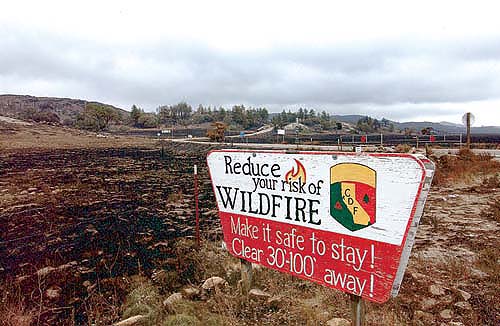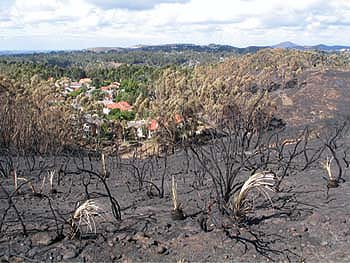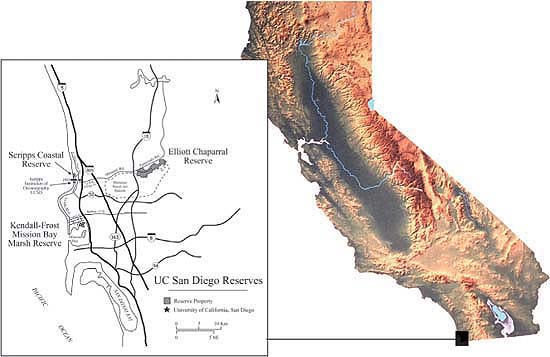All Issues
Toll-free number aids Spanish-speaking firestorm victims; UC reserve burns
Publication Information
California Agriculture 58(1):6-7.
Published January 01, 2004
PDF | Citation | Permissions
Full text
Within days of the devastating fires that swept through Southern California in late October, UC Spanish Broadcast and Media Services (SBMS) gathered and adapted information for Spanish-speaking people and quickly distributed the phone number to UC Cooperative Extension county offices, the media and relief agencies.
A statewide toll-free number, called “AsisTel de la UC,” had been announced Oct. 17 as part of a media campaign to provide Spanish-language materials for Diabetes Month in November. However, when the wildfires broke out, the phone number was quickly pressed into service to offer assistance to firestorm victims.
It now includes 31 concise messages in Spanish for dealing with the aftermath of wildfires, on topics ranging from completing insurance claims to the emotional well-being of adults and children.
“Many in the fire-ravaged communities are Latino immigrants, with limited information in Spanish to help guide their recovery,” says Myriam Grajales-Hall, SBMS program manager based at UC Riverside. “We hope these messages will help fill the gap in a useful, easily accessible manner.”
Recorded at the SBMS studio, the messages feature aid available through the U.S. Federal Emergency Management Agency, the Red Cross, the U.S. Small Business Administration and other local, state and federal agencies; information on insurance coverage and obtaining disability and unemployment insurance; and warnings about scams that tend to surface in the wake of disasters.
Staffer assists Latino victims
During a weekend of fires, Alberto Hauffen, a senior public information representative for UC's Spanish Broadcast and Media Services, anxiously watched flames approaching the East Highlands Ranch community in the San Bernardino Mountain foothills where he lives in with his wife and two children.
On Monday, Oct. 27, the fire was coming dangerously close to the Hauffen home, and people living two blocks north were ordered to evacuate. Fortunately, no houses were damaged and the fires were controlled by the next afternoon.
That evening, Hauffen went to a Red Cross shelter for evacuees in a hangar at the San Bernardino International Airport, which housed more than 900 people primarily from Big Bear, Arrowhead and other mountain communities.
“The Red Cross didn't have enough bilingual volunteers to assist non-English-speaking fire victims, so I offered to help,” Hauffen says.
Hauffen spent several days helping Red Cross officials with interpreting and translating messages for evacuees, and conveyed announcements over the PA system.
Some Latino fire victims expressed despair after being told they had to supply a Social Security number among other documentation in order to qualify for fire relief, Hauffen notes, as many are undocumented immigrants.
“These families, in my opinion, will be hit the hardest, since they depend on low-income jobs in construction and service in restaurants and hotels. They do not own homes in those pricey resort communities, but they feared to have lost whatever they had,” Hauffen recalls. “A single mother of four told me, ‘Now I'm left as I came: no job, no home, nothing’.”
Health concerns are addressed in guidelines for donating food to shelters, handling food safely when facing interruptions of power, and dealing with the ever-present blanket of ash, as well as recommendations regarding exposure to smoke and how to know if one's symptoms are smoke-related. Additional messages address handling ash and debris from burned structures and preparing for mudslides.
UC fire recovery resources
http://ucanr.org/firerecovery.shtml (English)
http://espanol.ucanr.org/Temas_Especiales/ (Spanish)
AsisTel de la UC (phone messages): (800) 514-4494
By Jan. 5, AsisTel de la UC had registered 478 calls. “We will continue updating the messages we provide through AsisTel de la UC on a regular basis, and will add new categories under the general natural disasters heading, such as floods and earthquakes,” Grajales-Hall says.
Cedar Fire hits UC wildland reserve
The Cedar Fire, which started on Oct. 25, raged through more than 280,000 acres in south San Diego County, killing 13 residents and one firefighter, and destroying more than 2,200 homes. It also burned most of Elliott Chaparral Reserve, a 183-acre wildlands site near Scripps Ranch that is part of the UC Natural Reserve System.
The site's rolling topography supports a diverse mixture of natural habitats, with an unusually wide variety of southern coastal chaparral. The Cedar Fire burned approximately 95% of Elliott's habitat.
“There are tiny patches that did not burn, in which birds are sheltering - quail, towhee, gnatcatchers, rufous-crowned sparrows,” says Isabelle Kay, reserve manager and academic coordinator.
Established in 1969, the reserve serves a small but dedicated group of long-term users. For example, Dan Udovich and others from University of Oregon have been researching the effects of floral predation on the pollination biology and reproductive success of the plant Yucca whipplei. Andrew Suarez of UC Davis and Ted Case of UC San Diego investigated the regional decline of native ants and their obligate predator, the coast horned lizard, due to an invasion of non-native Argentine ants.
Current research includes an investigation by David Holway and Sean Menke of UC San Diego into the effects of urban irrigation on the ability of Argentine ants to invade native ecosystems, and a survey of the distribution of the roadrunner by Mark Mendleson at San Diego State University. Both of these studies will continue, taking into account the burned conditions. The direction of work by Udovich will for the moment change in order to take advantage of the burst of recruitment by Yucca whipplei in response to the fire.
Fire is a natural part of the chaparral ecosystem and field scientists expect such wildlands to burn periodically. Furthermore, researchers now have the opportunity to study the role fire plays in stimulating the seedbank, recycling nutrients, altering vegetation and wildlife conditions, and reducing and creating future fire hazards. Kay is supervising a study by Bernice Ramirez, a high school student at the Preuss School on the UC San Diego campus into the effect of slope aspect, burn intensity and the presence of nonnative eucalyptus on the regeneration of the native vegetation.
There were no on-site buildings or other structures at Elliott Reserve, and only one house on adjacent land burned. Reserve personnel are now turning their attention to major safety concerns, such as unstable eucalyptus trees, gaps in the perimeter fencing previously filled by impenetrable chaparral and ordnance dating from World War II, which is now visible on the surface. Erosion on steep slopes is being monitored, but is expected to consist of ash rather than soil. This should not be a major problem since gentle winter rains have resulted in widespread germination of native seedlings and the deep roots of shrubs remain in place.
UC's Natural Reserve System manages 34 wildland sites in California, with 130,000 acres of relatively undisturbed samples of the state's natural habitats.








